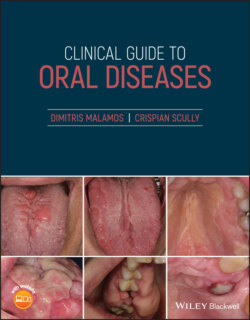Читать книгу Clinical Guide to Oral Diseases - Crispian Scully - Страница 41
Case 3.5
ОглавлениеFigure 3.5
CO: A 25‐year‐old woman was evaluated on a brown lesion on her lower lip.
HPC: The lesion was first noticed during her dental visits for a root canal treatment five months ago and since then, remains asymptomatic, although having a slight tendency of worsening during the last summer vacation.
PMH: A healthy young woman with no serious medical or dental problems who likeed to spend most of her free time in sea sports. She was not allergic to any foods or drugs and is averse to unhealthy habits such as smoking and drinking.
OE: The oral examination revealed a brown, well demarcated, superficial, discoloration on the vermillion border of the lower lip (Figure 3.5). The lesion was asymptomatic, soft in palpation, unchanged in pressure, without color variation or other similar, satellite‐like lesions on the lips and oral mucosa. The lower lip did not show any dryness, desquamation, or atrophy associated with bleeding. A few pigmented lesions on the skin of her nose and cheeks (freckles) were seen, which became darker in summers.
Q1 What is the possible diagnosis?
1 Melanotic macula
2 Fixed drug reaction
3 Melanoma
4 Actinic cheilitis
5 Hemangioma
Answers:
1 Melanotic macule or lentigolabialis is an asymptomatic brown lesion on the vermilion border of lower lip (mainly), tongue, buccal mucosae and gingivae (Figure 3.5).The lesion is well demarcated and uniformly pigmented with no proneness of malignant transformation.
2 No
3 No
4 No
5 No
Comments: The clinical characteristics (absence of satellite lesions or local lymphadenopathy as well as color variation with or without pressure) rules out labial melanoma and hemangioma from the diagnosis, respectively. The patient's preoccupation with sea sports, resulted in enhanced melanin production in summer, but this did not cause any dryness, desquamation, or lip atrophy as seen in actinic cheilitis. Fixed drug reaction requires drug uptake, but this is easily ruled out as the patient was not under any medication.
Q2 Which histological feature is/are pathognomonic of a melanocytic macule?
1 Increased size of melanocytes
2 Increased number of melanocytes
3 Elastosis
4 Hemosiderin deposition among epithelial layers
5 Atrophic mucosa
Answers:
1 No
2 Melanocytic macula is characterized by increased melanin production due to the increased number of melanocytes within the dermal–epidermal junction.
3 No
4 No
5 No
Comments: Chronic exposure of the labial mucosa to the sun can cause a great number of alterations ranging from innocent lesions as a result of increased melanin production (melanocytic macules) to those of intermediate risk due to any possible alteration in the epithelium atrophy and underlying submucosa (elastosis as seen in actinic cheilitis), or more severe effects threatening the patient's life (carcinomas) or melanomas. Haemosiderin deposition is irrelevant to solar radiation and strictly related to excess iron deposition within the body tissues.
Q3 What is the difference between café au lait lesions and melanotic macules?
1 Association with genetic disorders
2 Color
3 Presence of giant cell melanocytes in histological sections
4 Onset
5 Risk of malignant transformation
Answers:
1 Numerous café au lait lesions are associated with genetic disorders (i.e. neurofibromatosis 1) while melanotic macules are not.
2 No
3 Both lesions are characterized by increased melanin production but only café au lait lesions show giant cell melanocytes in microscopic examination.
4 Café au lait lesions are related to genetic disorders and appear from birth or childhood while melanotic macules can make their appearance at any age.
5 No
Comments: Both pigmented lesions clinically appear as brown to black discolorations with no tendency of malignancy.
